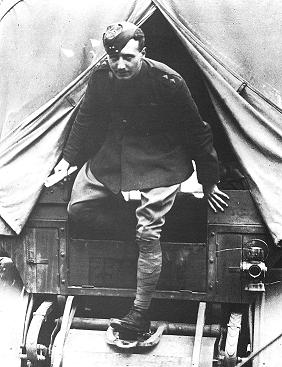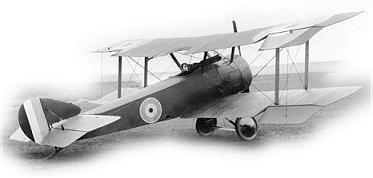Captain William Leefe Robinson, V.C. - Joins the Royal Flying Corps
With an African posting out of the question Robinson put in for a transfer to the Royal Flying Corps. The fledgling corps needed all the men it could get, and the request was immediately answered. On 29th March 1915 he was posted to No. 4 Squadron at St. Omer, under Major C.A. Loncroft, flying BE2c's in reconnaissance patrols over the German lines, and in the second week of April was made "efficient" and put on full pay. The work was exacting, calling for accuracy, and not without danger. The observers did invaluable service recording the location of the enemy, the accuracy of artillery fire, the size of enemy batteries and the direction in which each gun was facing. Robinson was now at last contributing, and from his letters home, it is clear he had at last found his element. "Talking of beauty, you have no idea how beautiful it is above the clouds. I have been up at about 5 o'clock on a still afternoon—you have no idea how glorious it is to gaze at the earth at 7,000 feet or over — But thrilling as that is, the real beauty comes with the clouds. Those rolling wastes of vapour of a hundred shades fading away till they terminate at the horizon into one straight line or rather circle which frames your view." The same letter, taken up a week later, continues "I love flying more and more everyday, and the work is even more interesting than it was." William found life with No. 4 Squadron to be comfortable. His letters written during April 1915 tell us what it was like to be stationed close to the enemy. The British airmen were heroes.
|
Lieut. William Leefe Robinson |
BE2c Biplane |
On the 8th May 1915 William Leefe Robinson flew his last patrol as observer. He was wounded by shrapnel bullet in his right arm while flying a dawn reconnaisance patrol over Lille, France. A letter to his mother written from Clapham on the 14th May breaks the news in a light hearted vein. I arrived there late Saturday night and was told I should probably go to England—great was my joy!" To his sister Ruth he confided "I shall be coming back to England for more training as soon I can break out of here (Boulogne). I am going to be a pilot—there's nothing like driving oneself about." |
After a months leave, Robinson reported at Farnborough on the 29th June 1915. The next day he was making his first flight under instruction. On 18th July he survived his first solo flight. On 28th July he qualified for his Royal Aero Club Certificate No. 1475 in a Maurice Farman. He had had a total of 230 minutes tuition. On 14th August he reported to the Central Flying School at Upavon for a course of advanced instruction. On the 15th September he gained his "wings." On the 18th he was appointed Flying Officer and seconded to 19 Squadron. On the 20th he reported to Captain R. M. Rodwell at Castle Bromwich. There is no letter home during this busy period, and it is 21 October before the eager pilot pens a long letter to his mother. |
Maurice Farman |
"You have just heard I have 'got my wings' — that is some time ago now. Ever since I've been here I've been acting as Flight Commander (a Captain's place) and second in command of the squadron . . . I have plenty to do with that alone what with 5 machines and about 35 men under me. I am also squadron photography officer and wireless officer, added to which my machines are the only ones which carry machine guns, so they and their fittings have to be looked after."
The six months training had clearly produced a better than average pilot, and Robinson is proud of his skill. He jokingly warns his mother not to make him more conceited than he already is by praising him but still cannot resist the next piece of news. "Now I'm going to give you an example of my abominable conceit. The other day it was most awfully windy, and I was the only flying officer allowed to go up—I took a passenger too. What do you think of a pilot who can pilot a machine and passenger through a 45 hour gale!"
Robinson's skills were the result of many hours flying. He was busy delivering aircraft, and instructing observers and trainee pilots. For the elite few of the R.F.C. life was never dull. "You seem to think whenever I go to town or anywhere I must have leave—not at all. I go "on duty." I have delivered and brought machines to and from Farnborough, Northolt (Harrow) and various other places and between times I manage to have a peep at 'Town' and my various friends there. Whenever I do, I have a simply ripping time. I landed for lunch near Banbury the other day—you are immediately surrounded by people offering you cars, lunch, tea, bed and the Lord knows what not. Of course, if you are wise you generally pick out the grounds of a country house or large villa of some kind to land in. My last landing was at Kenilworth. I had a passenger with me and we had the time of our lives Talk about autograph books and cameras. By gad, I was positively sick of seeing and signing my own signature. When I swore I would not sign another book one girl caught hold of my machine and said she would not leave go until I signed. So after much amusing argument I told her to give me the book whereupon I placed my filthy hand, writing 'The mark of an aviator, W. L. Robinson' over the top of the handmark—my hand was all dirty with the oil of the engine. The girl I liked best of all was a sweet little Flapper of about 17 called Kathleen Lennox for whom I drew our aeroplane. Another girl lent me her camera with which I took some photographs. She developed them and has just sent me some printed. We stayed at Kenilworth two days and a night!!!!"
This chatty account of "delivery boy" jobs begun on 21st October 1915 and was continued in the second part of the letter, now dated 10th December 1915;
"I have three observers and several flyers to instruct in my flight. I take passengers up every day. Last Tuesday I was to take a passenger to Gosport (other side of the river to Portsmouth). We got as far as Oxford when the weather—wind, rain and fog—got so bad, that we had to land. We saw a machine already on Port Meadow, so I landed there too. The other machine turned out to be one which my best friend here was also taking to Gosport. To shorten a long story we had an Al time in Oxford got the local police and volunteers to guard the machine—put up at the Mitre Hotel—Saw 'Deja vu' at the theatre, and enjoyed ourselves generally. We were followed about most of the time by a band of small boys who would insist on cheering every now and then. Next morning the sky was perfect—and we decided to go on our way via Farnborough where we would fill up our petrol and oil tanks.
I flew fairly high, touching nearly 9,000 feet. As luck would have it my engine began missing; I knew exactly what the matter was but could not remedy it in the air. The poor observer, a fellow who had only been in an aeroplane about once before in his life, grew quite nervous; he kept on passing back notes to me: 'The front part of the machine is vibrating horribly' — 'What is the matter with the engine?' `Will she hold out 'till we get to Farnborough?' etc. I laughed like anything at him, made a long nose and put my tongue out at him for a reply (you can't hear each other speak of course). Once or twice I held up my hands to show I wasn't holding anything—I thought the poor man would have a fit. Anybody who knew the least little bit about flying would know we were as safe as a rock. I then shut off the engine and did a long glide of about six miles into Farnborough aerodrome."



